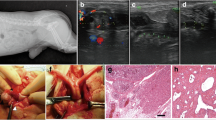Abstract
A 4-month-old phenotypic male with persistent müllerian duct syndrome (PMDS) is described. Serum levels of müllerian inhibiting substance (MIS) were undetectable in an enzyme immunoassay, consistent with a in an MIS gene. Normal germ cells were present in the testis, suggesting that subsequent azoospermia found in other patients with this abnormality is caused by a postnatal defect in germ cell development after 4 months of age. The testes were not attached by normal male gubernacula, but were loosely anchored by a long “round ligament” to the inguinal region. Failure of masculinasation of the gubernaculum in this syndrome suggests that MIS is responsible for early gubernacular development, and hence may have a role in testicular descent.
Similar content being viewed by others
References
Baker ML, Metcalfe SA, Hutson JM (1991) Serum levels of Müllerian inhibiting substance in boys from birth to 18 years, as determined by enzyme immunoassay. J Clin Endocrinol Metab 70: 11–15
Carragher AM, Boston VE (1987) MÜllerian inhibiting factor deficiency syndrome with crossed testicular ectopia. Br J Urol 60: 275–276
Gautier-Benort C, Bugnon PY, Servais B, Jean P (1990) Le syndrome d'ectopie testiculaire transverse avec persistance de vestiges mulleriens ou la bourse vide et le cordon trop plein. J Chir (Paris) 127: 286–289
Guerrier D, Tran D, Vanderwinden JM, Hideux S, van Lutryve L, Legeai L, Bouchard M, van Vliet G, de Laet MH, Picard JY, Kahn A, Josso N (1989) The persistent Müleerian duct syndrome: a molecular approach. J Clin Endocrinol Metab 68; 46–52
Gustafson ML, Lee MM, Asmundson L, MacLaughlin DT, Donahoe PK (1993) Müllerian inhibiting substance in the diagnosis and management of intersex and gonadal abnormalities. J Pediatr Surg 28: 439–444
Huff DS, Snyder H, Hadziselimovic F, Ruchelli E, Zderic S, Blyth B, Duckett J (1992) Failure of maturation of Ad-spermatogonia: a marker of the early endocrinopathy of cryptorchidism. Presented at the Am Acad Pediatr (Urol) meeting (abstract)
Hutson JM, Baker ML, Griffiths AL, Momose Y, Goh DW, Middlesworth W, Zhou BY, Cartwright EC (1992) Endocrine and morphological perspectives in testicular descent. Reprod Med Rev 1: 165–177
Hutson JM, Chow CW, Ng WD (1987) Persistent müllerian duct syndrome with transverse eesticular ectopia. An experiment of nature with clues for understanding testicular descent. Pediatr Surg Int 2: 191–194
Imbeaud S, Carre-Eusebe D, Boussin L, Knebelmann B, Guerrier D, Josso N, Picard JY (1991) Biologie moleculaire de l'hormone anti-müllerienne normale et pathologique. Annal d'Endocr (Paris) 52: 415–419
Josso N, Cate RL, Picard J-Y, Bigier B, di Clemente N, Wilson C, Imbeaud S, Pepinsky RB, Guerrier D, Boussin L, Legeai L, Carre-Eusebe D (1993) Anti-Müllerien hormone: the Jost factor. Recent Prog Horm Res 48: 1–59
Knebelmann B, Boussin L, Guerrier D, Legeai L, Kahn A, Josso N, Picard JY (1991) Anti-Müllerian hormone Bruxelles: a nonsense mutation associated with the persistent Müllerian duct syndrome. Proc Natl Acad Sci U S A 88: 3767–3771
Mahfouz EH, Issa MA, Farag TI, Nagiub KK, Al-Awadi SA (1990) Persistent Müllerian duct syndrome: report of two boys with associated crossed testicular ectopia. J Pediatr Surg 25: 692–693
Martin EL, Bennett AH, Cromie WJ (1992) Persistent Müllerian duct syndrome with transverse testicular ectopia and spermatogenesis. J Urol 147: 1615–1617
Mouli K, McCarthy P, Ray P, Ray V, Rosenthal IM (1988) Persistent Müllerian duct syndrome in a man with transverse testicular ectopia. J Urol 139: 373–375
Rangnekar GV, Loya BM, Goswani LK, Sengupta LK (1990) Premature centromeric divisions and prominent telomeres in a patient with persistent Müllerian duct syndrome. Clin Genet 37: 69–73
Wensing CJG (1986) Testicular descent in the rat and a comparison of this process in the rat with that in the pig. Anat Rec 214: 154–177
Zhou BY, Watts LM, Hutson JM (1993) The effect of Müllerian inhibiting substance (MIS) on germ cell development of the neonatal mouse testis in vitro. J Urol 150: 613–616
Author information
Authors and Affiliations
Additional information
Correspondence to: J. M. Hutson
Rights and permissions
About this article
Cite this article
Hutson, J.M., Davidson, P.M., Reece, L.A. et al. Failure of gubernacular development in the persistent müllerian duct syndrome allows herniation of the testes. Pediatr Surg Int 9, 544–546 (1994). https://doi.org/10.1007/BF00179676
Accepted:
Issue Date:
DOI: https://doi.org/10.1007/BF00179676




